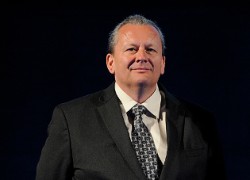
John Lammas, GE Vice President Thermal Engineering says that high-efficiency 9HA gas turbine technology should prove to be an appropriate solution for Europe, once market design takes into account the need for more secure, flexible gas-fired power to combat the volatility of renewables.
GE together with Toshiba announced a fresh order for the latest in its H-Class high efficiency combined cycle gas turbine technology this week requested by Hokkaido Electric Power. Although an Asian introduction Lammas sees there being a future point when the technology is increasingly relevant to Europe.Much of the content of Tuesday’s key note speeches at the POWER-GEN Europe event in Cologne, Germany centred on the need for a new market design aimed at assisting gas-fired power’s role in energy security for the bloc. Features inherent to the high-efficiency 9HA Gas Turbine destined for the Ishikariwan Shinko Power Plant Unit 1, HEPCO’s first liquefied natural gas (LNG) fuelled thermal power plant in Japan, look an ideal fit for Europe’s needs should a new design come into being.
“I see a situation in Europe where there is this great penetration of renewables and you need something that can respond when the sun isn’t shining and the wind isn’t blowing an I think that gas turbines are part of that solution,” Lammas told Power Engineering Internationalat the POWER-GEN Europe event. “It probably won’t be totally base load but you need flexibility which is another element that we are building into these machines; it’s that ability to get to full gas turbine output in approximately ten minutes and full plant in less than 30 minutes, which allows it to work in harmony with the renewables so we think long term there is definitely a future for these sorts of machines in Europe.”
The combined-cycle thermal power generation system combines GE’s latest high-efficiency 9HA Gas Turbine with Toshiba’s most-advanced steam turbine. Toshiba will be the prime contractor for the Hokkaido project. The gas turbine combined-cycle system ordered by HEPCO is expected to achieve a thermal efficiency of 62 per cent, the world’s highest1, at the lower heating value. The plant will have an output capacity of 569.4 MW and construction is expected to start in October 2015.
Lammas anticipates a worldwide demand for the newest in H-class. “Certainly there is a trend in the industry towards the larger machines to get the CAPEX advantage at the plant level and then high efficiency particularly where gas prices are high; around the world this is a trend we are seeing. The machine we are building is greater than 61 per cent. Obviously as we test the machine we will be able to potentially improve that efficiency rating but it brings value from both the CAPEX element and the operational cost as well.
Brian Gutknecht, Vice President Thermal Engineering at GE told the POWER-GEN Europe show newspaper that there was another key advantage to their latest offering. “Through this plant we offer the lowest life cycle cost of electricity. Compared to prior F-Class technology it’s about a 5 per cent reduction in cost of electricity that would translate to $21m per year of net savings at the life cycle value; that would be for a 9HA02 plant running at about 6000 hours a year. So balancing the higher performace with low maintenance costs as well.”








